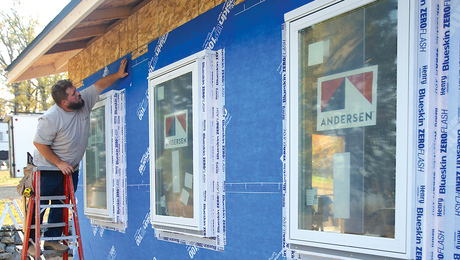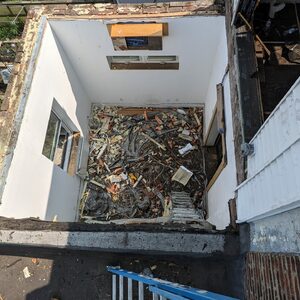I’m using a PT 2×12 for a Rim joist with 2×12 floor joists. The Rim joist is 1/8in to 1/4in higher than the floor joists. Should I shim the floor joists prior to the installation of the sub-floor to even it up or just subfloor over it and keep framing, because it will eventually shrink to the level of the floor joist?
Discussion Forum
Discussion Forum
Up Next
Video Shorts
Featured Story

Getting the details right for a wall assembly with the control layers to the exterior and lots of drying potential.
Featured Video
How to Install Cable Rail Around Wood-Post CornersHighlights
"I have learned so much thanks to the searchable articles on the FHB website. I can confidently say that I expect to be a life-long subscriber." - M.K.
Fine Homebuilding Magazine
- Home Group
- Antique Trader
- Arts & Crafts Homes
- Bank Note Reporter
- Cabin Life
- Cuisine at Home
- Fine Gardening
- Fine Woodworking
- Green Building Advisor
- Garden Gate
- Horticulture
- Keep Craft Alive
- Log Home Living
- Military Trader/Vehicles
- Numismatic News
- Numismaster
- Old Cars Weekly
- Old House Journal
- Period Homes
- Popular Woodworking
- Script
- ShopNotes
- Sports Collectors Digest
- Threads
- Timber Home Living
- Traditional Building
- Woodsmith
- World Coin News
- Writer's Digest


















Replies
I am by no means an expert - actually a newbee
But that is what I would do. (Shim up joists) I think I also read/saw to do just that from one of the finehomebuilding books on framing. It makes a lot of sense too because you want your subflooring to be on a nice flat surface -- ps remember to glue subflooring before you nail with ring shank or deformed nails (or better yet screw) -- I highly recommend PL Premium glue - that stuff is great
Rip the rim joist.
I wouldn't bother shimming it.
Around here treated lumber is usually kept outdoors and not covered up. So it's usually wet. Non-treated lumber is virtually always kept inside. So it's usually dry.
As your treated rim joist dries out it will probably shrink to about the same size as the joists.
Pressure Treated Rim/Band
Why would you use pressure treated material for the rim/band?
why use PT wood
harryvermehren wrote:
Why would you use pressure treated material for the rim/band?
if I were the building code king all rim joists would be PT.
Leaks under patio doors, regular doors etc which cause rot are real expensive to fix.
Ed
Proper installation of that door or anything else will prevent the water intrusion.
the first line of defense is the cheapest answer in the long run.
Yeah, but with home construction "belt and suspenders" is generally not a bad idea.
Proper belt OR proper suspenders and........
Your pants won't fall down . You won't go wrong with best practices.
if the rim is susceptible to rot then so would the subfloor, the finished floor and the joist ends be.
You never know when some landscaper is going to decide that it would be cool to mound dirt up against the foundation.
Well then,
Best build your fool proof house on stilts and like the other guy, sheet it with treated ply.
or
go back to the cave.
Well, I've seen rotted rim joists in several homes, due to the soil "creeping up" on the foundation for one reason or another.
That it'll shrink is a given
but, where? The bottom or the top?............perhaps the middle?
The purpose of the rim joist is mainly to hold the joists straight upright-keep them from rolling, and to keep them to layout. Structurally the load is carried "mainly" by the joists themselves. An eigth to a qtr isn't going to make too much difference in the scheme of things.
Keep the joists themselves in plane would be my goal. Crown them and keep the deviations consistant.
However, I'm no engineer or species specialist.
"The purpose of the rim joist is mainly to hold the joists straight upright-keep them from rolling, and to keep them to layout."
I disagree. The rim joist supports the load bearing wall above the joists.
Ron
I should have added that I would hold the joists up to the top of the rim and as it shrinks and settles the bottoms would probably come to rest on the sill.
And too, that "most" of the load is carried by the joists.
In stack framing as I was taught (not in school but in the mud), the studs sit directly above the floor joists, the ceiling joists and rafters directly above the studs. The only time they were allowed to be in a different position was when the top plates were doubled (2' centers on the wall studs-16" on the joists and rafters).
In the frame, think of all of them as lined up point loads leading to the foundation.
The band that parallels the run of the joists, we would block between it and the 1st joist. Some inspectors would require us to do that according to layout of the wall (some would not give a hoot).
I did mention that I've no engineering experience and will defer to you and whomever knows way more background than I. To prove your point-most header kings and bucks rest solely on the plate and rim joist below.
I should have also mentioned that I'm just a dumb carpenter with no formal schooling but those lessons in the mud.
There may be some regional differences here.
I've never seen framing stacked. I've heard people talk about it, but have never seen it done.
With I-joist floors, the rim board is expected to take all the load. The brands I'm familiar with are capable of carrying about 2,000 PLF. That's a lot of load. The ends of I-joists aremn't designed to be in compression. (Although I realize that's not what we're talking about in this thread)
BTW - I don't consider you dumb in any way. There's nothing wrong with 2 reasonable people disagreeing.
well, heck yeah~
Here's some difference also-squash blocks and 3/4 ply for the band. The only two times I've used I-joists, that was the method.
pressure treated usually shrinks more
What boss hog said. But that's the short sory.
.